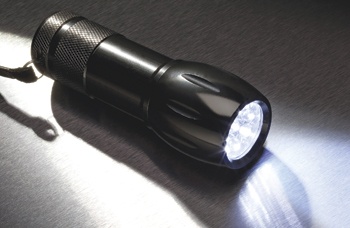Consumers might just be getting used to compact fluorescent lamps (CFLs), but the lighting industry is hard at work perfecting the next greatest thing—lighting composed of light-emitting diodes (LEDs). Don’t worry about having to throw out your CFLs any time soon, however. There are still a lot of kinks to work out before an entire home can be illuminated cost-effectively with LEDs.
Within a decade, or perhaps sooner, LEDs will be the predominant lighting product. They are 50 to 60 percent more energy efficient than incandescent lighting and 25 to 30 percent more energy efficient than CFLs. The most efficient already operate 50,000 to 100,000 hours or 10 to 12 years longer than CFL lighting, according to the industry. The solid-state diodes are already in use for landscaping, flashlights, holiday lights and traffic signals, to name a few applications.
Experts at the Cooperative Research Network (CRN), a national co-op organization testing LEDs, say that electricity savings from computer-chip-driven LEDs will be one of the most important factors in reaching government-mandated energy-efficiency standards by 2020. LEDs could account for up to 30 percent of the savings.
In 2003, Austin replaced incandescent bulbs with LED bulbs in all city traffic signals. The city reports it has reduced energy usage by 7.25 million kilowatt-hours and saved the city $1.4 million on traffic signals. Houston is doing the same and estimates the new bulbs will eventually save taxpayers $10,000 a day. Fast-food chains and other businesses that stay open 18 to 24 hours a day are also reaping savings. However, the high cost of LEDs for home lighting that is used for only a few hours a day would be hard to justify as of yet.
A Boerne-based company, GreenStar, is making street and commercial lighting with great promise. A new owner moved administrative headquarters from Mexico to the Hill Country, but LEDs are still being manufactured south of the border. Because the lighting is already being distributed in countries such as Mexico and Honduras, it is manufactured to operate on various voltages without changing the fixtures. Bandera Electric Cooperative has purchased GreenStar fixtures and is measuring their efficiency.
LED claims are exciting, but the nation’s cooperatives want to test them independently. “We are fortunate that through cooperation, the National Rural Electric Cooperative Association can fund sophisticated, independent research such as that done by CRN,” said Mike Williams, president/CEO of Texas Electric Cooperatives, the statewide association.
In late December, CRN hosted a “webinar” for cooperative leaders interested in monitoring research on LEDs. Cooperatives are looking first to use LEDs to replace outdoor mercury vapor, metal halide or low-pressure sodium lighting. Those who fired up their computers and dialed in to the briefing learned that LEDs are still in the experimental phase but are rapidly improving. Martha J. Carney of Outsourced Innovations told those participating in the seminar that LEDs have many advantages, come in a variety of fixtures and are hard to damage. The U.S. Department of Energy expects LEDs to parallel CFLs in performance within five years.
These are some of the other points CRN emphasized in the web conference:
• LEDs perform well in frigid climates, but research must be done in the desert.
• They operate cooler to the touch than other forms of lighting.
• The quality of current products varies widely, so don’t believe everything vendors tell you. Many products on the market today are not delivering as promised.
• Light shifting or dimming can be a problem—for example, white light shifting toward blue. Look at the variety of colors in current LED auto headlights.
• The semiconductor chips in LEDs must be protected from the fixture’s heat source. Heat’s proximity to the chip reduces efficiency.
• Retrofitting with LEDs is not as simple as changing bulbs.
• It currently takes eight to 12 months for LED chips to be manufactured.
The bottom line: Be encouraged but cautious.
——————–
Kaye Northcott is retired editor of Texas Co-op Power.


